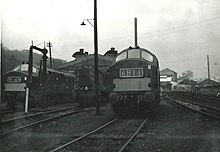BR class 37
| BR class 37 | |
|---|---|
|
37 421 in Strathcarron (Scotland) , 1989
|
|
| Numbering: | 37 010-899 |
| Number: | 308 |
| Manufacturer: | English Electric (Vulcan Foundry) and Robert Stephenson and Hawthorns |
| Year of construction (s): | 1960-1965 |
| Axis formula : | Co'Co ' |
| Gauge : | 1435 mm ( standard gauge ) |
| Length over buffers: | 18,750 mm |
| Service mass: | 102 t / 107 t / 122 t |
| Top speed: | 145 km / h |
| Hourly output : | 1305 kW |
| Starting tractive effort: | 247 kN |
| Driving wheel diameter: | 1143 mm |
The British Rail Class 37 - original series EE3 (English Electric Type 3) - one from the United Kingdom originating series of diesel-electric locomotives for use on passenger and freight trains , between 1960 and 1965 by English Electric and Robert Stephenson and Hawthorns built has been. As part of the TOPS renumbering, the EE3 series was renumbered as Class 37 in 1972, with the change in the addresses on the vehicles dragging on over several years. It is the "little sister" of the EE4 ( British Rail Class 40 ), to which it looks very similar.
history

The machines were to be found on the entire British Rail network and were transferred to private railway companies after the state railway was broken up. Their number remained almost unchanged for 35 years, and it was not until the end of the 1990s that an increasing number of Class 37 were withdrawn. Until 2010, DB Schenker Rail UK also had locomotives of this type. The first machines delivered had a front door between the split “headcode box” for the train number display, but this was hardly used and was later omitted.
In the 1980s, Class 37 was extensively rebuilt in the BREL works (British Rail Engineering Limited), the sub-series 37/4 and higher were created. Locomotives in the original design remained as type 37/0. Machines that only received exchange bogies in various depots became sub-series 37/3.
The substructure type 37/4 operated in Scotland and Wales . Thanks to its electric train heating, it could be used in front of passenger trains all year round. In April 2011, the 37/4 that were still in operation were transferred from DB Schenker Rail UK to Direct Rail Services (DRS).
Conversion machines similar to the 37/4, but without electric train heating, were combined to form the 37/5 sub-series. Locomotives of the series with a split “headcode box” were assigned numbers from 37 501 upwards, those from group 37 120 to 37 308 from 37 699 downwards. The machines 37 601 to 37 613, on the other hand, belong to substructure type 37/6, they were converted again for use in front of Nightstar trains.
The sub-series 37/7 corresponded to the type 35/5, but received an additional ballast weight. It was specially converted for heavy freight traffic in South Wales and comprised 44 machines. In 1986 and 1987 the newly motorized base type 37/9 followed for the same purpose.
In 2013, a number of Class 37 were still in use at different companies and in different colors. Several vehicles have been preserved as museums or for special traffic. The 37 119, which was first built as the D6700 (converted to 37 350), is in the green BR paint scheme in the National Railway Museum in York .
The machines 37100, 37170, 37178 and 37217 were equipped by Network Rail with the European Rail Traffic Management System (ERTMS) and were painted yellow. They are as Class 97 (97301 to 97304) are mainly used in Wales on the routes from Shrewsbury to Aberystwyth and Pwllheli .
Sub-types and vehicle numbers
- 37/0: 37 010–37 384 standard version, the first 119 machines with a split “headcode box” and front door, from 37/3 exchange bogies type CP7 for 130 km / h
- 37/4: 37 401–37 430 Conversion to alternating current generator and electric train heating, exchange bogies type CP7
- 37/5: 37 503–37 698 (without 37 601–37 613) Conversion to an alternator, no train heating
- 37/5: 37 601–37 613 conversion from 37/5 for the traction of Nightstar trains
- 37/7: 37 701–37 899 conversion to an alternator, no train heating, additional ballast weight
- 37/9: 37 901–37 906 Conversion to an alternator, new engines, additional ballast weight
37 038 in the colors of Direct Rail Services
literature
- Howard Johnston, Ken Harris: Jane's Train Recognition Guide. HarperCollins Publishers, London 2005, ISBN 0-06-081895-6 , p. 382
- Andrew Walker, John Walker, Vaughan Hellam: Class 37 Locomotives , Amberley Publishing, Stroud 2016, ISBN 978-1-4456-5737-0









